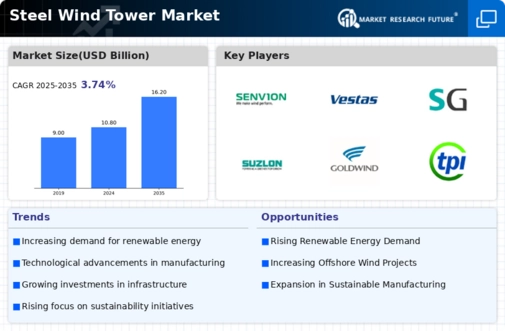Top Industry Leaders in the Steel Wind Tower Market

*Disclaimer: List of key companies in no particular order
Top listed global companies in the industry are:
- CS Wind Corporation (SOUTH KOREA)
- KGW Schweriner Maschinen-UND Anlagenbau Gmbh (GERMANY)
- Dongkuk S&C (SOUTH KOREA)
- Shanghai Taisheng Wind Power Equipment Co., Ltd. (CHINA)
- Windar Renovables (SPAIN)
- Arcosa Inc. (US)
- Ventower Industries LLC (US)
- Broadwind (US)
- Nordex Group (GERMANY)
- Suzlon Group (INDIA) and others.
Gearing Up for the Wind: Navigating the Competitive Steel Wind Tower Market
The global steel wind tower market is a fiercely contested arena where established players and innovative companies battle for dominance. Understanding the strategies underpinning this competition, the factors influencing market share, and emerging trends is crucial for navigating this dynamic landscape.
Key Players and their Strategies:
- Global Giants: Goliaths like Shanghai Electric and Ming Yang Smart Energy leverage their extensive production capacities, global reach, and brand recognition to secure a significant market share. Shanghai Electric offers diverse tower solutions for onshore and offshore applications, while Ming Yang excels in customized designs for complex wind farm projects.
- Regional Champions: Companies like Siemens Gamesa Renewable Energy and Vestas dominate specific geographies by tailoring solutions to regional regulations and wind farm conditions. Siemens Gamesa caters to Europe's stringent standards, while Vestas excels in high-capacity towers for offshore wind farms.
- Agile Innovators: Startups like CS WIND Corporation and Dajin Heavy Industry are disrupting the market with innovative approaches. CS WIND focuses on cost-effective modular tower designs, while Dajin Heavy Industry pushes the boundaries of using high-strength steel for lighter and more efficient towers.
Factors for Market Share Analysis:
- Product Breadth and Depth: Offering a range of towers for diverse wind turbine capacities, rotor diameters, and site conditions expands market reach and caters to varied customer needs.
- Cost-Effectiveness: Balancing advanced features with affordability is crucial, especially in cost-sensitive emerging markets. CS WIND's modular towers exemplify this focus.
- Technological Innovation: Integrating advanced materials like high-strength steel, advanced welding techniques, and smart monitoring systems enhances tower strength, efficiency, and lifespan. Dajin Heavy Industry's advanced steel grades illustrate this.
- Logistics and Assembly Expertise: Efficient transportation, on-site handling, and assembly capabilities are critical for large-scale wind farm projects. Shanghai Electric's global logistics network exemplifies this strength.
Emerging Trends and Company Strategies:
- Modular Tower Design: Utilizing prefabricated sections for faster and more cost-effective on-site assembly is gaining traction. CS WIND's modular tower systems exemplify this trend.
- Focus on Offshore Wind: Growing investments in offshore wind farms are driving demand for specialized towers designed for harsh marine environments. Siemens Gamesa's offshore towers exemplify this focus.
- Digitalization and Automation: Integrating Building Information Modeling (BIM) for optimized design and digital tools for remote monitoring and maintenance is gaining traction. Ming Yang Smart Energy's smart tower solutions illustrate this trend.
- Sustainability Focus: Reducing the environmental impact of tower manufacturing and using recycled materials is gaining importance. Dajin Heavy Industry's focus on green steel production exemplifies this commitment.
Overall Competitive Scenario:
The steel wind tower market presents a dynamic landscape where global giants face challenges from regional players and innovative startups. Success hinges on offering diverse and cost-effective tower solutions, embracing technological advancements like modular designs and digitalization, catering to the growing offshore wind segment, and prioritizing sustainability. Companies demonstrating agility, logistical expertise, and a commitment to responsible manufacturing hold a strong hand in navigating this competitive and ever-evolving market.
Latest Company Updates:
November 2023- The year 2023 doesn't sound like a good time to be a wind power startup. Take Ørsted, the Danish wind company: It recently announced that it would be taking a charge of up to USD 5.6 billion this year, partly because of various wind projects being canceled, including a large one off the coast of New Jersey. The decision was driven by inflation, high-interest rates, and supplier delays, the company said. Bad timing indeed, unless you're a company that thinks the old way to design wind farms is all wrong. Neal Rickner, CEO of AirLoom Energy and former COO of Makani, the Google X wind power spinout, said that wind turbines are big and getting bigger. That limits where they can be deployed. It limits site development: You can't go to the mountains. It's really hard to go to low-wind sites; most of the high-wind sites have been built. He further added that if you're looking for additional sites to build, [traditional] horizontal turbines become less and less attractive.
AirLoom is what you would call a nontraditional form of wind power, and naturally, it seeks to fill the gaps Rickner listed while also bringing the price down significantly. The startup has been operating under the radar (until now, at least), and it already has a small prototype up and running at its headquarters adjacent to the regional airport just outside Laramie, Wyoming. The prototype works like this: A cable runs in a track atop a series of 25-meter (82-foot) tall poles arranged in an oval. Vertically oriented, 10-meter (33-foot) long blades are attached to the cable to intercept the wind as it travels down both the home and the backstretch of the cable's track. A power takeoff sits on one of the poles, connecting the system to the grid. AirLoom's president and co-founder, Robert Lumley, first sketched the concept on a napkin a decade ago and spent the intervening years working out the details and starting the company. He was inspired by kiteboarding, a hobby of his while attending a wind energy conference in Berlin.

